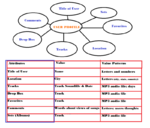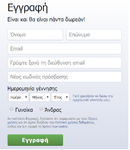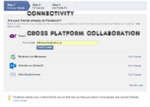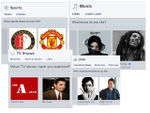Mediaobjectnikosssss
notes after steve tutorial (ideology of choice, explain technolibertarian utopias and the self, explain how it works with a database in a database in database, explain the user as producer and producer of ecology and site Olga G , define restricted lists as templates, john tagg book. photos related to topologies and taxonomies, criminals and photo collection , fv profile pic and mugshot, elaborate on manovich position database narrative etc) N= corporate definition-front end abstraction, fb pattern classification-connectivity, on Olga G also “Το υποκείμενο παράγεται από τη σχέση και την αμείλικτη διαμάχη μεταξύ έμβιων όντων και μηχανισμών.”
from Giorgio Agamben, What is an apparatus,Η ταυτοποίηση όμως δεν εξυπακούεται πως είναι και αναγώγιμη στην ταυτότητα. (becomimg from identification)
---
User profile is supposed to digitaly represent one s identity 1, but it is forming and constructing the individual, particularly in the online world. As a media object it talks about identity curation and construction, power and control, and social hierarchies.As a collection of settings and structured metadata it documents the users identity while forming it through the selection from a limited range of choices and an algorythmic approach to the person. Moreover it provides a template for exercise of control between corporation and their user and among users themselves. User profiles are very common new media objects and can be found in operating systems and in online services and websites, chatrooms and forums . Their existence and growth has been in parallel with the transition from earlier web to the cloud. Social networking, Web2.0 and personalisation of information and services are based upon user profiles.
According to Microsoft, "your user profile is a collection of settings that make the computer look and work the way you want it to. It contains your settings for desktop backgrounds, screen savers, pointer preferences, sound settings, and other features. User profiles ensure that your personal preferences are used whenever you log on to Windows. A user profile is different from a user account, which you use to log on to Windows. Each user account has at least one user profile associated with it.2
According to Facebook, "Your profile, is your collection of the photos, stories and experiences that tell your story. Your profile also includes your Timeline". This definition can be found in their Glossary of Terms, where other interesting approaches can be found (what is a friend?Friends are people you connect and share with on Facebook and what is a list?Lists are an optional way to organize your friends on Facebook. )3
Outside the corporate definition framework and ignoring for now that both definitions from Microsoft and Facebook focus clearly on the "front end" and avoid to explain how all this is constructed, one can see that user profiles are attached to the concepts of customisation, authentication, identification and engage the individual in a process of terms and rules accepting. They are collections of settings and metadata associated with a specific user. And they differ from user accounts as a more public expression of them. However, to create a profile one must create an account, either in operating systems or in social networking services. Both accounts and profiles are subject to archiving from the providers and offer a great documentation of the individual which happens silmutaneously with the profile construction. As Facebooks puts its, the user profile is the collection that tells our story.
This process of building ones user profile beginns indeed with an account creation(registration ),accepting terms of services, and verification (via personal email),and later on moves to public profile construction, adjusting personalised settings and filling personal information in existing categories.
The design model of the user profile is the one of the database. Moreover this database driven formation of the online profile is happening within online structures that are themselves databases. For example, when I create an online profile in Facebook, what I do is filling in a database(my profile), my action is happening in a database (Facebook) which happens to exist in "another databse", the Internet. This documents simply the multiplicity of layers of databases that construct online space and its interfaces. Even the layers from user accounts to user profiles consist from different databases.
It seems that identity and database have a structural relationship in the world of user profiles. According to Mark Poster, because of its structure constitutes individuals by manipulating bits of information4 . This illustrates how an identity is formed within a user profile: through language , data entries and the relationships formed among data within the database. Manovich, who talks about the antinarative nature of the web, refers to the database as a new way to structure our experience of ourselves and the world . He talks also about the projection of the ontology of computers to culture; the world is reduced to data structures and algorithms. Applying this idea to the self, we see the current state of production of the self dominated by data structures and algorithms. Sociologist Giddens has written about the reflexive project of the self, where the subject, within information overload and fragmentation has to be able create a coherent personal narrative, in order to reflect and understand itself. If we apply Manovich's thinking as a response to Giddens, we would encounter the antinarrative web and the databases as enemies of any self-reflection. Morevoer we could easily see that the story facebook claims that tells about us is problematic by definition. Morozov in his book Net delusion analyzes the movie The Lifeof the others to result that the Internet police was able to just " see the subjects of surveillance reduced to one-dimensional, boring database entries".
User Profile is a linguistic construction that mediates a social construction: one;s identity/ies. But what identity is it mediating?By providing a very controled space and using controled vocabulary puts the individual in the position to enter data in the database that will regenerate the persons identity in the context of that system. This linguistic construction mediates at the same time the choices of the individual alltough they are template choices. The use of these choices, from food preferences to the choices that affect what kind of data we contribute, show that our user profiles mediate a controled curation of identity. It is this controlled curation that illustrates the technolibertarian utopias related to identity exploration and alternative identities. The internet as a tool for personal freedom, the multiple identities, the personal webpage as emancipatory media(Cheung), the early work of Turkle, all these ideas collapsed particularly within the social networking era.
User profile assigns also that identity with specific regulations , duties and rights predetermined, therefore mediates power relations and control. These relationships are formed not only between the institution/corporation and the user but even among users themself. A feature of facebook, the report of a user, is examplary of that. Again this relationships can be traced as well within one's self: one of one;s identities controling another. Furthermore, power and control are based on the practise of one documenting him/herself while creating all this accounts and profiles. From a preselected range of choices, understandable from computers, one is documenting in a written record him self by self-classification and data entering.This process affects not only self-presentation but self-understanding as well.
It also mediates certain hierarchies, within society and within one 's self. In order to create a profile in a social network for example one has to be present through ones account in an operating system, lets say Windows. And reversed, ones online profiles lead back to ones profile in the operating system. Maintaining profiles in operating systems involves again hierachies, by distinguishing administrators by user and assigining specific regulations or rights to them. In the online context, the administrator of our profiles becomes the webservice providor, the corporation.
During her lectures What was the user, Olg G has spoken about the user as producer of himself. While this user is producing himself, the ecology of the medium is also produced she claims. Applying this thinking on user profiles online we find users constructing themselves by filling databases, while contributing to the never ending economy of online media, which is based on user's online performance. Giorgio Agamben, writes also : a subject is that which results from the relation and – so to speak- from the relentless fight between living beings and apparatuses(quoted in Dragona)
from nickname to name: The history of chatrooms, forums and social networking sites proves that the "real" name of a user was and is not always needed in the formation of ones profile. Chatrooms for example have been requiring users to create profiles under nicknames asking for their email of course for "verification" reasons. There are plenty websites that are web2.0 products that require one to create a profile in order to construct his/her collections. A good example would be Pinterest. In their majority these webservices allow user to use a fictional name in their profile. Lately, Facebook and Google+ have been doing important movements related to user "real" names. Facebook and its strict policy which is under ongoing acceleration, with the latest to exclude drag-queens using stage names. Their alternative for all these users is to create a Fun page. The feedback of the users is an interesting point, while in facebook a common practise that emerged after these policies was the report from one user to another. Tim Carmody writes about the "great Google+ profile purge", explaining how Google+ changed its "real name" policy, promise for more transparency and after some time lots of profiles that didnt obey just dissapeared. He calls it" Social media as a means to establishing identity"6. He continues that Google wants your real name because simply it has much more value in advertising, to cross relate your account to your buying behaviour.
portraits and profile pictures: is a very visual but also psychological concept that can be found in any kind of art and includes normally a face and its charakteristics. In modern society , portrait relates with photography as a means to understand , monitor and document the world and the individual. Gallison and Daston in their book Objectivity comment on the relation of the lense(from microscopes to cameras) with scientific objectivity, which they see a the suppression of some aspect of the self 7. Moreover, Evi Sambanikoy source 8writes about the photographer as the reporter of the objectified subject.8 John Tagg in his book ....writes about thevery complex indexical nature of photography, opposes to the realistic points of Barthes and exposed instumental photography as a means of classification and control. He also talks about portrait as signs with purpose "both the description of an individual and the inscription of social identity", while it "is also a commodity". Our portraits in our user profiles are our profile pics. The selfie corresponds to the "democratisation" of the use of the camera by individuals and appears succesfull in motivating people document themselves online.Ludovico and Cirio, in their "facetofacebook:smiling in the eternal party" refer to the face as a major point of reference in the world, stronger even than names .They argue that facebook profiles are so effecting in representing real people through a a specifi element:the profile picture.9 They also connect profiles pictures with the technology of facial recognition and its possible use by authorities.
email= identification or identity: E mail is used here in order to offer the company a "verification" that we are humans and that we consiously create our profile. It is also used in order to extract data about our emailing list and to force connectivity from the beginning of our profile life. Alltough there are different systems of verification, creating online profiles without email is /should be extremely rare and of course doesnt happen in the online big media.
+++++ User authentication , mozilla persona.
password:a PASSword makes it perfektly clear that the access to the online self is through language codes. Is serves as the greatest application of personalisation with regards to privacy and security. Still, creating passwords online can always be surveilled by corporations which offer the whole environment of password creation. Passwords are also subject to computer viruses. So the privacy of the user can be hacked. If the password technology is not safe enough then what is in the end the reason of using it? Sam Williams, an author that wrote a book about the life of Richard Stallman, reffers to Stallmans "aversion to passwords and secrecy" from 1982 , which became so popular that "users outside the AI Laboratory were using his account as a stepping stone to the ARPAnet". His practise consequently broke MIT system's privacy and exposed it to individuals outside of it. The story continues with the administrators demanding him to stop his open practise while Stallman's response was to stop using the system due to his personal ethics. Stallmans views against privacy and password was rooted to his belief that the security regime shouldnt be supported.
-
social networking and user profiles
process of becoming (screenshots interpretation() categories and protokols elaboration, facebook API lists etc
end
User profiles are linguistic constructions, which occur in very linguistic structures, starting from the source code of websites we use to computers as linguistic devices and our linguistic-textual participation) and are the constructions that produce the self of the online user.
creates algormithmically individuals by suggesting friends , likes, trying to create a COHERENT identity (g+ utube example), restricted from protocols, archived, connected strategically , unified.
sources
1. User Profile, wikipedia 2. What is your user profile, Microsoft, 3. User Profile, Facebook glossary of terms 4. Poster, Mark . The mode of information 5. Manovich, Lev. Database as symbolic form 6. Carmody, Tim.Google+ Identity Crisis: What’s at Stake With Real Names and Privacy 7. Gallison and Daston. Objectivity. 8. Sambanikou. 9. Cirio and Ludowico, Face to facebook. 10. Terence mc Keena, lecture; the world is made of language 11. Stallman password story
olga g. olia l john tagg net delusion dragona-frown-the endless game of the self with the mechanism Giorgio Agamben, What is an apparatus
free as in freedom sam williams











